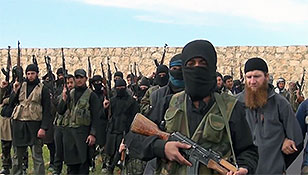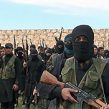
“Obliged to Unite under One Banner”: A Profile of Syria’s Jaysh al-Muhajireen wa’l-Ansar
Publication: Terrorism Monitor Volume: 11 Issue: 8
By:

A video posted on YouTube in the last week of March documented the unification of two Syrian armed groups; the Katibat al-Khattab (Army of Khattab Brigades) and the Katibat Jaysh al-Muhammad (Army of Muhammad Brigades), with the Katibat al-Muhajireen (KaM – the Brigade of Migrants). [1] The video showed armed men giving their bayat (allegiance) to the amir of the Katibat al-Muhajireen, Abu Omar al-Shishani, an ethnic Chechen from Georgia’s Pankisi valley. The newly unified groups announced their incorporation into a new movement using the name Jaysh al-Muhajireen wa’l-Ansar (JMA – the Army of Migrants and Supporters) and under the command of al-Shishani (“The Chechen”). Like its components, the new movement will continue to be dedicated to helping Syrians topple the rule of Syrian president Bashar al-Assad. [2]
Various languages including Arabic, Chechen and Turkish can be heard in the background of the video, as well as various Arabic accents (Saudi, Libyan, etc.). This linguistic variety can also be heard on other of the movement’s video releases. [3]
In one video, the group’s media arm, Liwa al-Mujahedeen al-Ilami (the Mujahedeen Media Battalion) showed a Han Chinese jihadist speaking in Mandarin. [4] Bo Wang, as the jihadist was identified in the video, apologized to the Syrian people for his country’s support to the regime and also “warned the Chinese government to immediately stop all forms of aid to Bashar al-Assad’s regime.” He also urged his fellow Chinese Muslims to join the jihad in Syria, though it is rare to find jihadists of Han ethnicity.
The KaM was formed in the rural areas of Latakia (northwest of Damascus) in mid-2012 by Libyan volunteers who joined the Syrian revolution after toppling Mu’ammar Qaddafi’s regime in Libya. However, the leadership of the group is currently dominated by Chechens. With a membership of roughly 1,000 fighters, the Muhajireen operate in various areas of Syria and have seen action primarily in the Aleppo area (Kavkaz.tv, March 26). The KaM also coordinated attacks with other armed groups in Syria, especially with the jihadist group Jabhat al-Nusra (JaN), which renewed its allegiance to al-Qaeda leader Ayman al-Zawahiri in mid-April (al-Shorfa.com, April 15). One of the best known of these joint attacks was the assault on Air Defense Brigade 602’s base in the Handarat district of Aleppo (Jabhat al-Nusra, Statement No. 166, November 21, 2012; as-ansar.com; al-Jazeera Arabic TV, November 6, 2012).
According to the group’s media official, Abu Hamza al-Muhajir, the Muhajireen have the following beliefs:
- The movement rejects takfir-ism (the right to excommunicate Muslims accused of apostasy or other offenses). Excommunication of any Muslim is not allowed even if he commits adultery, drinks alcohol or commits a theft unless he considers such acts permissible. Anyone who does not believe in Islam is a kafir (infidel).
- Any land not under Islamic government is part of Dar al-Kufr (Land of the Infidels).
- Secularism with its various flags and ideologies (Nationalism, Communism and Ba’athism) is kufr bawah (manifest disbelief) and anyone who believes in it is a non-Muslim.
- The ummah (Muslim community) and especially the mujahideen are “obliged to unite under one banner.”
- Jihad will continue “to the Day of Judgement.” According to Abu Hamza, “This is not Afghanistan or Bosnia or Chechnya, this is the land of al-Sham [greater Syria], Issa [Jesus], peace be upon him, will come down here and the Dajal [false Messiah, or Anti-Christ] will come out here; it is the land of epics and the land of resurrection.”
- Harming any Muslim is prohibited.
- Defensive jihad is fard ‘ayn (individually obligatory) on each Muslim individual.
- It is unanimously agreed that the kufr (disbelief) of the murtadeen (apostates to Islam) is a greater offense than original kufr (i.e. the disbelief of non-Muslims) and it is thus a priority to fight the apostates. [5]
Like most jihadist groups, the leadership structure of the Muhajireen consists of a military leadership, a Shari’a committee, a Shura council and a media arm, Liwa al-Mujahideen al-Ilami. The latter was established during the Bosnian civil war (1992-1995) by foreign mujahideen who joined the fight against Serbian militias. [6] This media arm appears to have been revived for the production of videos on behalf of the foreign fighters in Syria. The videos produced by Liwa al-Mujahedeen al-Ilami in Bosnia in the 1990s include influential productions such as “Badr al-Bosna” and “Jihad al-Bosna,” which played a major role in attracting young Muslims (especially in the West) to the Bosnian jihad. [7] This media group appears to have the same goals in Syria.
The Muhajireen’s successful military campaigns and its co-ordination with other armed groups (jihadists in particular) have played a major role in making the group attractive for foreigners and locals alike.
The Muhajireen have entered into coalitions with other jihadist groups in the northwestern province of Latakia, establishing a branch under the name of Majlis Shura al-Mujahideen in the Jabal Turkman mountain range of northern Syria and opening a “mujahideen operations room” in Kurd Dagh (“the Kurd Mountain,” one of the three “ethnic mountains” in northwestern Syria). The Muhajireen also work closely in a military and administrative sense with Jabhat al-Nusra, an al-Qaeda affiliated movement that is the strongest single militia in Syria.
Until recently, the Muhajireen appear to have operated under the influence of Jabhat al-Nusra, but have moved on to establish a coherent organization, conduct successful attacks against regime forces and earn the acceptance of locals in their operational areas. The group now continues to operate in coordination with Jabhat al-Nusra but is no longer under its direct leadership. As the conflict continues, it is likely that the Muhajireen will play a more prominent role in the struggle for control of Syria.
Notes
1. The name of the Khatibat al-Khattab refers to the late Saudi leader of Arab volunteers in Chechnya, Amir al-Khattab (a.k.a. Samir Saleh Abdullah al-Suwailem). He was fatally poisoned by Russian security agencies in 2002. The Amir had borrowed his nom-de-guerre from Omar ibn al-Khattab, the second caliph of Islam (579-644 C.E.).
2. For the statement, see https://www.youtube.com/watch?feature=player_embedded&v=2mPyJV5lSN8. Muhajireen is a name commonly used to refer to foreign fighters in various jihadi battlefields such as Afghanistan, Iraq, Bosnia, Chechnya, etc. The term reflects the Prophet Muhammad’s hijra (migration) to Madina in 622 to escape persecution in Mecca. In Madina Muhammad created the first Islamic state based on the alliance between al-muhajireen (migrants) and al-ansar (local supporters).
3. For example, see “Dairy of a Mujahid in the Land of the Levant,” https://www.youtube.com/watch?v=D0LWJj4ebpM.
4. See https://www.youtube.com/watch?v=uI3cxTjmr00.
5. “Interview with Abu Hamza al-Muhajir [official of Katibat al-Muhajireen’s media arm],” Islamic News Agency (Haq), April 14, 2013, https://www.asansar.com/vb/showthread.php?t=84252.
6. Ibid.
7. These videos available at: https://www.jarchive.net/categories.php?cat_id=9&sessionid=921e999c80d807bef8b2484b4a2ee84f.





